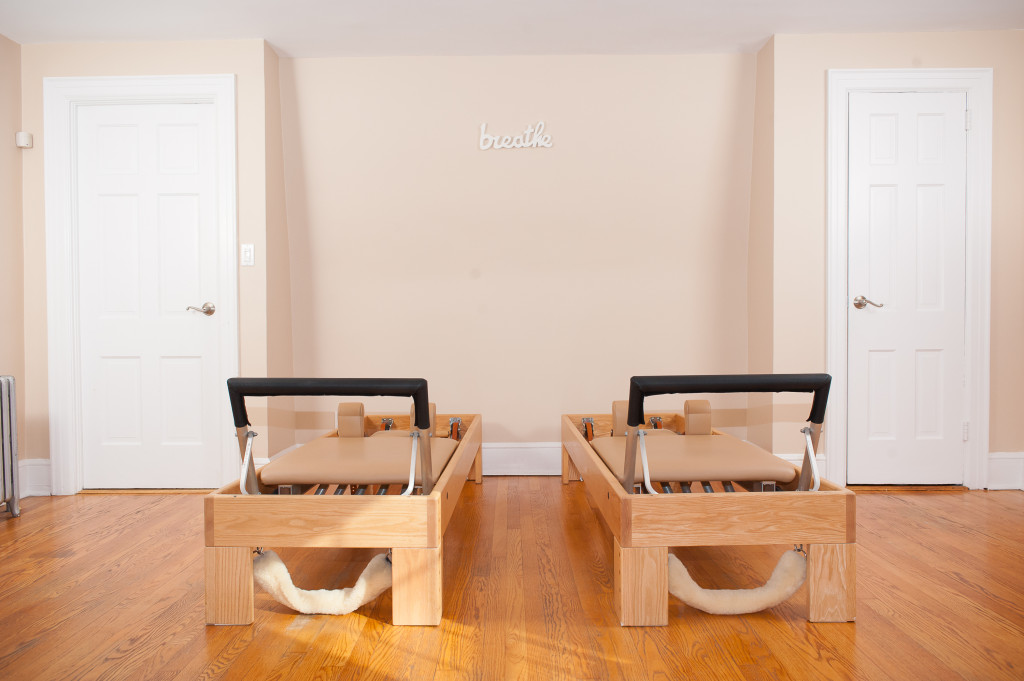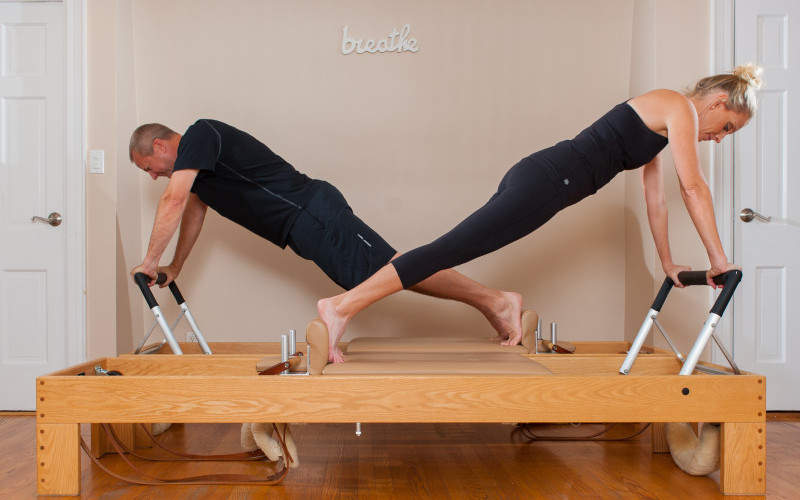If you are like most new clients contemplating whether or not to try Pilates, you might be a bit nervous about your first class. I certainly was. Growing up in Germany, I had learned the Pilates mat exercises as part of my dance training, but I had no idea that there were also machines involved.
Before moving to New York, I was pulled aside by two experienced German dancers, who had studied here, and was told in a conspiratorial tone, that I must find “Pilates” if I wanted to have a healthy dance career. So after my arrival, one of the first things I did (after finding a room that did not have too many mice and cockroaches), was to go to my first Pilates class. I walked up the rickety steps to the studio on Broadway and 74th with a sense of impending doom. Once I entered and saw the scary looking machines and people doing even scarier looking exercises on them, I wanted to flee. I am glad I stayed however, because the same Pilates that once scared the heck out of me, has turned out to be my life’s work and my calling.
That first Pilates studio was quite dark and intimidating. Black equipment, dark grey walls and a sense of military rigor conveyed by the teachers, made me uncomfortable. I stayed however, because I fell in love with the machines (called “apparatus”) and the exercises and I want you to fall in love with them too. I have made it my mission to make my own studio the opposite of that first studio. I want Movement and Wellness to be friendly and comfortable and I want to make Pilates fun for you.
Here is what I wish I had known that very first day:
1) What to Wear?
Wear comfortable (but not too loose fitting) workout clothes, that do not ride up or fall down. You will spend a lot of time with your legs up in the air or your body bent forward. Constantly tugging down a shirt or pulling up your pants will annoy and distract you. Guys, who wear shorts for Pilates, usually wear bicycle shorts or long boxer briefs under them. Otherwise your instructor might get to see more than he or she bargained for. Women usually wear workout leggings with a higher rise. Although low-rise pants are fashionable, they ride down during certain exercises and you will have the Pilates version of a “Plumber’s Crack”.
Very loose clothes can get caught in the springs and other parts of the equipment and can be dangerous. The same goes for long hair. It needs to be tied up neatly, so it won’t get caught. I have gotten my hair caught in the equipment and it hurts!
You do not wear shoes for Pilates. I often practice with bare feet, but some studios require socks. Find out, if you will need socks and invest in some grippy ones, that will prevent slipping. Shashi and Crescent Moon both make great sticky socks. Slipping on the equipment can be distracting as well as dangerous.
2) What to Expect
During your first lesson, the instructor will likely walk you through a series of beginner exercises, including a warm up, abdominal work and leg, arm and back exercises on one or more pieces of Pilates equipment, we call “apparatus”. Each movement will strengthen you, while also increasing your flexibility. Your instructor will ask you among other things, about your injuries, medical conditions, previous exercise history and your current goals. Make sure you speak up! Most Pilates instructors are very good at reading bodies, but we are not mind-readers. If something hurts, is uncomfortable or you do not feel it working, speak up. Pilates lessons are a collaborative effort between the instructor and the client. Sometimes all it takes is a small adjustment to make you more comfortable or to increase the challenge, so don’t be afraid to ask.
3) How to Prepare
Make sure that you are well hydrated. It helps to drink about 20 oz of water an hour before your lesson. You might not have a lot of time during the lesson to drink. I was parched during my first class, but did not get a water break (my first teacher was like a drill sergeant). Also make sure that you are not famished. Low blood sugar, combined with the constant position changes in Pilates can cause dizziness or nausea. A snack containing protein and carbohydrates (eg an apple with Peanut Butter) before class will help, if you are hungry. However, do not eat a big meal before Pilates. You will spend time lying on your stomach and on your back. If your stomach is too full, you will be uncomfortable.
4) Give it some time
I got enough out of my first lesson to know that Pilates was worth pursuing further. To say that I loved it right away however, would be a lie. The more I practiced Pilates, the more I understood the method and the more it benefitted my body. Give it at least 10 lessons, to decide if it’s right for you. Oprah said that there is much more of a learning curve to Pilates than other forms of exercise, but if you hang in there and are patient, the rewards can be life-changing.
5) Studio Etiquette
At bigger studios, make sure to arrive early enough to sign in, fill out any paperwork, change into your workout clothes and go to the bathroom. Sometimes the reception desk is busy or there is a wait for the bathroom, so give yourself enough time. My studio is small and I do not have a waiting area, so you can arrive closer to your appointment time. My studio has a bathroom, where you can change. You can sit in the waiting chair or stretch, while you wait for your appointment.
In most studios, you will have to turn off your cell phone, so as not to disturb other clients. Since my studio only offers private appointments, I don’t mind, if you leave your phone on. If you have children or are on call for work, it might help you relax more, if you know that you are reachable. On the other hand, if your phone rings constantly and makes it impossible for you to focus, you might want to turn it off. Generally, Pilates studios do not allow you to bring your children, but I personally don’t mind. Some of my clients occasionally bring their (preschool age or older) kids and let them read, color or play games during the lesson. Other clients have older children, who work out with them here. Again, since my studio is small and private, it’s just us, so your child won’t disturb anyone. I think it’s great for children to be exposed to mindful exercise early on.
6) Pilates Lingo
Apparatus: The exercise equipment invented by Joseph H. Pilates, our method’s genius founder. The most commonly used pieces are the Universal Reformer, the Cadillac (aka Trapeze Table), the Wunda Chair and the High Ladder Barrel. During your lessons, you will be gradually introduced to all the apparatus, but you will most likely spend most of your time on the reformer.
Matwork: A series of 34 or more exercises practiced on a mat, without using the apparatus. These are the exercises you might be familiar with from a gym class or Pilates DVD. Some matwork is usually incorporated into each Pilates lesson.
The Powerhouse: The Pilates term for your core: the muscles of the abdomen, lower back, as well as your pelvis. In Pilates the powerhouse is working in every single movement.
Pilates Stance or Pilates “V”: Standing or lying down with your heels pressed together and your toes rotated slightly apart. The hips are externally rotated so that your feet make a “V” shape.
“Belly-button (or navel) to spine”: The action of pulling your stomach in, as if you were trying to button jeans that are too tight. This engages your deep abdominals and helps you stabilize your spine.
Each instructor has his or her own cueing style, favorite imagery and vocabulary. If you don’t understand something he or she says, please ask. You will get so much more out of your lesson, if you know what your instructor is talking about. Above all, just remember to enjoy the experience and listen to your body. Before you know it, you will feel and see the difference in your body.
Warmly,





My partner and I would like to learn more about your classes